STS-51
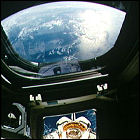 Space Shuttle Discovery lifts off on the 57th shuttle mission, a nine-day stay in orbit to release a communications satellite and test a new second stage engine designed to push that satellite into geosynchronous orbit. A free-floating ultraviolet spectography experiment is released from the shuttle’s cargo bay and retrieved before the end of the mission, and spacewalking techniques for the upcoming Hubble Space Telescope repair mission are practiced. Aboard Discovery for her 17th flight are Commander Frank Culbertson Jr., Pilot William Readdy, and mission specialists James Newman, Daniel Bursch and Carl Walz.
Space Shuttle Discovery lifts off on the 57th shuttle mission, a nine-day stay in orbit to release a communications satellite and test a new second stage engine designed to push that satellite into geosynchronous orbit. A free-floating ultraviolet spectography experiment is released from the shuttle’s cargo bay and retrieved before the end of the mission, and spacewalking techniques for the upcoming Hubble Space Telescope repair mission are practiced. Aboard Discovery for her 17th flight are Commander Frank Culbertson Jr., Pilot William Readdy, and mission specialists James Newman, Daniel Bursch and Carl Walz.
STS-57
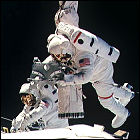 NASA launches Space Shuttle Endeavour on a mission lasting almost ten days to test the SPACEHAB pressurized lab module. A long-term exposure experiment is retrieved for ESA, though a spacewalk must be undertaken when its antennae fail to stow themselves away automatically for insertion into the cargo bay. Aboard Endeavour for her fourth flight into orbit are Commander Ronald Grabe, Pilot Brian Duffy, Payload Commander G. David Low, and mission specialists Nancy Sherlock, Peter Wisoff and Janice Voss.
NASA launches Space Shuttle Endeavour on a mission lasting almost ten days to test the SPACEHAB pressurized lab module. A long-term exposure experiment is retrieved for ESA, though a spacewalk must be undertaken when its antennae fail to stow themselves away automatically for insertion into the cargo bay. Aboard Endeavour for her fourth flight into orbit are Commander Ronald Grabe, Pilot Brian Duffy, Payload Commander G. David Low, and mission specialists Nancy Sherlock, Peter Wisoff and Janice Voss.
STS-55
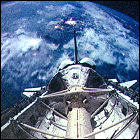 Space Shuttle Columbia lifts off on a mission lasting nearly ten days, carrying the Spacelab laboratory module in its cargo bay. This flight, Spacelab D-2, includes medical and material experiments, with one experiment controlled by an Apple Macintosh computer carried into orbit. Amateur radio messages are exchanged with the crew of the Mir space station. Aboard Columbia for her 14th flight are Commander Steven Nagel, Pilot Terence Henricks, mission specialists Jerry Ross, Charles Precourt and Bernard Harris Jr., and payload specialists Ulrich Walter and Hans Schlegel.
Space Shuttle Columbia lifts off on a mission lasting nearly ten days, carrying the Spacelab laboratory module in its cargo bay. This flight, Spacelab D-2, includes medical and material experiments, with one experiment controlled by an Apple Macintosh computer carried into orbit. Amateur radio messages are exchanged with the crew of the Mir space station. Aboard Columbia for her 14th flight are Commander Steven Nagel, Pilot Terence Henricks, mission specialists Jerry Ross, Charles Precourt and Bernard Harris Jr., and payload specialists Ulrich Walter and Hans Schlegel.
STS-56
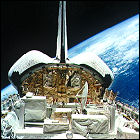 Space Shuttle Discovery lifts off with the ATLAS-2 scientific payload for a nine-day mission. A free-floating platform to measure solar wind activity is also deployed and then retrieved before returning to Earth. Aboard Discovery for her 16th flight are Commander Kenneth Cameron, Pilot Stephen Oswald, and mission specialists Michael Foale, Kenneth Cockrell and Ellen Ochoa.
Space Shuttle Discovery lifts off with the ATLAS-2 scientific payload for a nine-day mission. A free-floating platform to measure solar wind activity is also deployed and then retrieved before returning to Earth. Aboard Discovery for her 16th flight are Commander Kenneth Cameron, Pilot Stephen Oswald, and mission specialists Michael Foale, Kenneth Cockrell and Ellen Ochoa.
The International Space Station
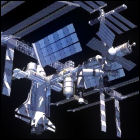 Having drawn the European Space Agency and Japan into partnerships for the still-on-the-drawing-board Space Station Freedom project, NASA announces that it is reaching out to post-Soviet Russia, not just for ideas and engineering expertise, but to become partners in the new space station. With already-built modules sitting on the ground for a Mir 2 station that it cannot afford to launch and operate on its own, Russia becomes a full partner in what will now become the International Space Station. Plans are accelerated for proposed missions to dock the Space Shuttle to the existing Mir space station, and to use Russian Soyuz capsules for crew transfer and return.
Having drawn the European Space Agency and Japan into partnerships for the still-on-the-drawing-board Space Station Freedom project, NASA announces that it is reaching out to post-Soviet Russia, not just for ideas and engineering expertise, but to become partners in the new space station. With already-built modules sitting on the ground for a Mir 2 station that it cannot afford to launch and operate on its own, Russia becomes a full partner in what will now become the International Space Station. Plans are accelerated for proposed missions to dock the Space Shuttle to the existing Mir space station, and to use Russian Soyuz capsules for crew transfer and return.
STS-54
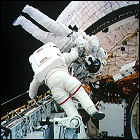 Space Shuttle Endeavour lifts off on the 53rd shuttle flight, a six-day mission to launch the fifth TDRS (Tracking & Data Relay Satellite) and perform assorted experiments. A five-hour spacewalk is conducted in the cargo bay to practice spacewalking techniques for future missions. Aboard Endeavour for her third flight are Commander John Casper, Pilot Donald McMonagle, and mission specialists Mario Runco, Gregory Harbaugh and Susan Helms.
Space Shuttle Endeavour lifts off on the 53rd shuttle flight, a six-day mission to launch the fifth TDRS (Tracking & Data Relay Satellite) and perform assorted experiments. A five-hour spacewalk is conducted in the cargo bay to practice spacewalking techniques for future missions. Aboard Endeavour for her third flight are Commander John Casper, Pilot Donald McMonagle, and mission specialists Mario Runco, Gregory Harbaugh and Susan Helms.
STS-53
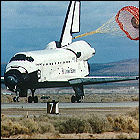 Space Shuttle Discovery lifts off on the 52nd shuttle flight, a seven-day mission to deploy a classified Department of Defense payload and conduct various science experiments within the shuttle itself. Flying Discovery on its 15th launch are Commander David Walker, Pilot Robert Cabana, and mission specialists Guion Bluford, James Voss and Michael Clifford.
Space Shuttle Discovery lifts off on the 52nd shuttle flight, a seven-day mission to deploy a classified Department of Defense payload and conduct various science experiments within the shuttle itself. Flying Discovery on its 15th launch are Commander David Walker, Pilot Robert Cabana, and mission specialists Guion Bluford, James Voss and Michael Clifford.
STS-52
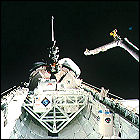 Space Shuttle Columbia lifts off on the shuttle program’s 51st flight, a ten-day mission to launch Laser Geodynamic Satellite II and the cargo-bay-mounted U.S. Microgravity Payload experiment package. Aboard Columbia for her 13th flight are Commander James Wetherbee, Pilot Michael Baker, mission specialists Charles Veach, William Shepherd and Tamara Jernigan, and payload specialist Steven MacLean.
Space Shuttle Columbia lifts off on the shuttle program’s 51st flight, a ten-day mission to launch Laser Geodynamic Satellite II and the cargo-bay-mounted U.S. Microgravity Payload experiment package. Aboard Columbia for her 13th flight are Commander James Wetherbee, Pilot Michael Baker, mission specialists Charles Veach, William Shepherd and Tamara Jernigan, and payload specialist Steven MacLean.
STS-47
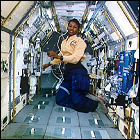 Space Shuttle Endeavour lifts off on the 50th space shuttle mission (and its own first return flight to orbit). Carrying the Spacelab module in its cargo bay, Endeavour hosts the first Japanese shuttle astronaut and the first African-American woman in space. Over eight days, the crew performs various science experiments. Endeavour is flown by Commander Robert “Hoot” Gibson, Pilot Curtis Brown, Payload Commander Mark Lee, missions specialists Jan Davis, Jay Apt and Mae Jemison, and payload specialist Mamoru Mohri.
Space Shuttle Endeavour lifts off on the 50th space shuttle mission (and its own first return flight to orbit). Carrying the Spacelab module in its cargo bay, Endeavour hosts the first Japanese shuttle astronaut and the first African-American woman in space. Over eight days, the crew performs various science experiments. Endeavour is flown by Commander Robert “Hoot” Gibson, Pilot Curtis Brown, Payload Commander Mark Lee, missions specialists Jan Davis, Jay Apt and Mae Jemison, and payload specialist Mamoru Mohri.
STS-46
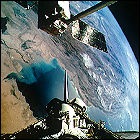 Space Shuttle Atlantis is launched on an eight-day mission to deploy two experiment packages developed jointly with the European and Italian space agencies. (The mission is extended by a day to accomodate more experiments.) Aboard Atlantis for her 12th flight are Commander Loren Shriver, Pilot Andrew Allen, mission specialists Jeffrey Hoffman, Franklin Chang-Diaz, Claude Nicollier and Marsha Ivins, and payload specialist Franco Malerba.
Space Shuttle Atlantis is launched on an eight-day mission to deploy two experiment packages developed jointly with the European and Italian space agencies. (The mission is extended by a day to accomodate more experiments.) Aboard Atlantis for her 12th flight are Commander Loren Shriver, Pilot Andrew Allen, mission specialists Jeffrey Hoffman, Franklin Chang-Diaz, Claude Nicollier and Marsha Ivins, and payload specialist Franco Malerba.
STS-50
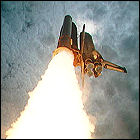 NASA launches Space Shuttle Columbia on the 48th shuttle mission (Columbia’s 12th trip into orbit). Using the Spacelab module, Columbia’s crew conducted the first USML (United States Microgravity Laboratory) flight, as well as testing a new system called the EDO (Extended Duration Orbiter) package, allowing the crew to stay in orbit longer than any previous shuttle (or, for that matter, lunar) flight. Aboard Columbia for the record-breaking 13-and-a-half-day mission are Commander Richard N. Richards, Pilot Ken Bowersox, Payload Commander Bonnie Dunbar, mission specialists Ellen Baker and Carl Meade, and payload specialists Lawrence DeLucasand Eugene Trinh.
NASA launches Space Shuttle Columbia on the 48th shuttle mission (Columbia’s 12th trip into orbit). Using the Spacelab module, Columbia’s crew conducted the first USML (United States Microgravity Laboratory) flight, as well as testing a new system called the EDO (Extended Duration Orbiter) package, allowing the crew to stay in orbit longer than any previous shuttle (or, for that matter, lunar) flight. Aboard Columbia for the record-breaking 13-and-a-half-day mission are Commander Richard N. Richards, Pilot Ken Bowersox, Payload Commander Bonnie Dunbar, mission specialists Ellen Baker and Carl Meade, and payload specialists Lawrence DeLucasand Eugene Trinh.
STS-49: Endeavour’s first flight
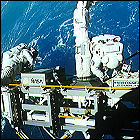 Space Shuttle Endeavour leaves Earth for the first time, carrying a crew of seven to orbit on the 47th shuttle mission. Over nearly nine days, three spacewalks are taken up with the tricky and dangerous task of capturing a four-and-a-half-ton communications satellite into Endeavour’s cargo bay to repair and relaunch it. (The satellite, Intelsat VI, had been stranded in the wrong orbit since its 1990 launch aboard a Titan rocket.) The record-setting spacewalks involved – each lasting over seven hours and marking the first time three astronauts have operated outside their vehicle – force NASA to cancel one of two experimental EVAs to test space station construction techniques. Endeavour’s first crew consists of Commander Daniel Brandenstein, pilot Kevin Chilton, and mission specialists Pierre Thuot, Kathryn Thornton, Richard Hieb, Thomas Akers and Bruce Melnick.
Space Shuttle Endeavour leaves Earth for the first time, carrying a crew of seven to orbit on the 47th shuttle mission. Over nearly nine days, three spacewalks are taken up with the tricky and dangerous task of capturing a four-and-a-half-ton communications satellite into Endeavour’s cargo bay to repair and relaunch it. (The satellite, Intelsat VI, had been stranded in the wrong orbit since its 1990 launch aboard a Titan rocket.) The record-setting spacewalks involved – each lasting over seven hours and marking the first time three astronauts have operated outside their vehicle – force NASA to cancel one of two experimental EVAs to test space station construction techniques. Endeavour’s first crew consists of Commander Daniel Brandenstein, pilot Kevin Chilton, and mission specialists Pierre Thuot, Kathryn Thornton, Richard Hieb, Thomas Akers and Bruce Melnick.
STS-45
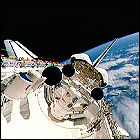 NASA launches Space Shuttle Atlantis on the 46th shuttle mission, carrying the Spacelab-based ATLAS (Atmospheric Laboratory for Applications and Science) experiment module. Aboard Atlantis for the nearly-nine-day flight are Commander Charles Bolden, Pilot Brian Duffy, Payload Commander Kathyrn Sullivan, mission specialists David Leestma and Michael Foale, and payload specialists Byron Lichtenberg and Dirk Frimout. NASA extends the mission by one day to accomodate additional experiments.
NASA launches Space Shuttle Atlantis on the 46th shuttle mission, carrying the Spacelab-based ATLAS (Atmospheric Laboratory for Applications and Science) experiment module. Aboard Atlantis for the nearly-nine-day flight are Commander Charles Bolden, Pilot Brian Duffy, Payload Commander Kathyrn Sullivan, mission specialists David Leestma and Michael Foale, and payload specialists Byron Lichtenberg and Dirk Frimout. NASA extends the mission by one day to accomodate additional experiments.
STS-42
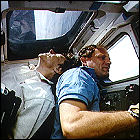 Space Shuttle Discovery lifts off for an eight day Spacelab mission, with an multi-national crew participating in “IML-1” (International Microgravity Laboratory) experiments. Discovery’s crew for this flight consists of Commander Ronald Grabe, Pilot Stephen Oswald, mission specialists Norman Thagard, David Hilmers, and William Readdy, and payload specialists Roberta Bondar and Ulf Merbold.
Space Shuttle Discovery lifts off for an eight day Spacelab mission, with an multi-national crew participating in “IML-1” (International Microgravity Laboratory) experiments. Discovery’s crew for this flight consists of Commander Ronald Grabe, Pilot Stephen Oswald, mission specialists Norman Thagard, David Hilmers, and William Readdy, and payload specialists Roberta Bondar and Ulf Merbold.
STS-44
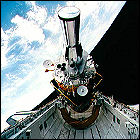 NASA launches Space Shuttle Atlantis on a mission lasting nearly a week, deploying both classified and unclassified payloads for the Defense Department. After the payload deployments, tests are conducted to determine the viability of the shuttle orbiters for long-duration missions. Manning Atlantis for this mission are Commander Frederick Gregory, Pilot Terence Henricks, and mission specialists Mario Runco, James Voss, Story Musgrave and Thomas Hennen.
NASA launches Space Shuttle Atlantis on a mission lasting nearly a week, deploying both classified and unclassified payloads for the Defense Department. After the payload deployments, tests are conducted to determine the viability of the shuttle orbiters for long-duration missions. Manning Atlantis for this mission are Commander Frederick Gregory, Pilot Terence Henricks, and mission specialists Mario Runco, James Voss, Story Musgrave and Thomas Hennen.
STS-48
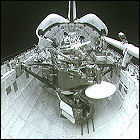 Space Shuttle Discovery lifts off on a five-day mission to deliver the Upper Atmosphere Research Satellite (UARS) into a low Earth orbit, where the satellite spends over a year studying the outer layers of Earth’s atmosphere. UARS also focuses on study of Earth’s ozone layer. Other experiments are carried out aboard the orbiter by Commander John Creighton, Pilot Kenneth Reightler, , and mission specialists Mark Brown, Charles Gemar and James Buchli.
Space Shuttle Discovery lifts off on a five-day mission to deliver the Upper Atmosphere Research Satellite (UARS) into a low Earth orbit, where the satellite spends over a year studying the outer layers of Earth’s atmosphere. UARS also focuses on study of Earth’s ozone layer. Other experiments are carried out aboard the orbiter by Commander John Creighton, Pilot Kenneth Reightler, , and mission specialists Mark Brown, Charles Gemar and James Buchli.
STS-43
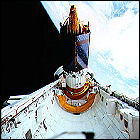 NASA launches Space Shuttle Atlantis on a satellite deployment and science mission lasting nearly nine days. The fourth TDRS (Tracking & Data Relay Satellite) is launched, and several experiments are performed on board, including materials processing experiments. Atlantis’ crew consists of Commander John Blaha, Pilot Michael Baker, and mission specialists Shannon Lucid, James Adamson and David Low.
NASA launches Space Shuttle Atlantis on a satellite deployment and science mission lasting nearly nine days. The fourth TDRS (Tracking & Data Relay Satellite) is launched, and several experiments are performed on board, including materials processing experiments. Atlantis’ crew consists of Commander John Blaha, Pilot Michael Baker, and mission specialists Shannon Lucid, James Adamson and David Low.
STS-40
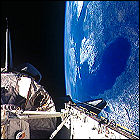 Space Shuttle Columbia lifts off on a nine-day mission with – for the first time in the shuttle program – a crew that’s nearly 50% female. Columbia carries the Spacelab module into orbit for a series of life sciences and biology experiments, the first flight devoted to such experiments since the Skylab era. Aboard Columbia for this flight are Commander Bryan O’Connor, Pilot Sidney Gutierrez, and mission specialists James Bagian, Tamara Jernigan, Rhea Seddon, Drew Gaffney and Millie Hughes-Fulford.
Space Shuttle Columbia lifts off on a nine-day mission with – for the first time in the shuttle program – a crew that’s nearly 50% female. Columbia carries the Spacelab module into orbit for a series of life sciences and biology experiments, the first flight devoted to such experiments since the Skylab era. Aboard Columbia for this flight are Commander Bryan O’Connor, Pilot Sidney Gutierrez, and mission specialists James Bagian, Tamara Jernigan, Rhea Seddon, Drew Gaffney and Millie Hughes-Fulford.
STS-39
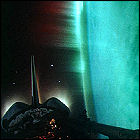 Space Shuttle Discovery lifts off on an eight-day mission to delivery both classified and unclassified Defense Department payloads into Earth orbit. Aboard the shuttle for this flight are Commander Michael Coats, Pilot Blaine Hammond, and mission specialists Guion Bluford, Gregory Harbaugh, Richard Hieb, Donald McMonagle and Charles Veach.
Space Shuttle Discovery lifts off on an eight-day mission to delivery both classified and unclassified Defense Department payloads into Earth orbit. Aboard the shuttle for this flight are Commander Michael Coats, Pilot Blaine Hammond, and mission specialists Guion Bluford, Gregory Harbaugh, Richard Hieb, Donald McMonagle and Charles Veach.
STS-37
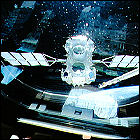 Space Shuttle Atlantis lifts off on a mission to deploy the orbiting Gamma Ray Observatory satellite. When the high-gain antenna fails to deploy on GRO, the first unplanned spacewalk since 1985 is conducted, with two of the astronauts manually releasing the antenna. Manning Atlantis for nearly six days are Commander Steven Nagel, Pilot Kenneth Cameron, and mission specialists Jerry Ross, Jay Apt and Linda Godwin.
Space Shuttle Atlantis lifts off on a mission to deploy the orbiting Gamma Ray Observatory satellite. When the high-gain antenna fails to deploy on GRO, the first unplanned spacewalk since 1985 is conducted, with two of the astronauts manually releasing the antenna. Manning Atlantis for nearly six days are Commander Steven Nagel, Pilot Kenneth Cameron, and mission specialists Jerry Ross, Jay Apt and Linda Godwin.
STS-35
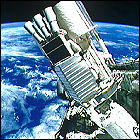 Space Shuttle Columbia lifts off for an eight-day mission to become a manned space telescope in Earth orbit, carrying the ASTRO-1 package designed to conduct X-ray and ultraviolet astronomy, mounted on an unmanned Spacelab pallet in the cargo bay. The mission has been delayed for months, most notably by hydrogen leaks detected long before the original May launch date. Manning Columbia for this flight are Commander Vance Brand, Pilot Guy Gardner, mission specialists Jeffrey Hoffman, John Lounge and Robert Parker, and payload specialists Samuel Durrance and Ronald Parise.
Space Shuttle Columbia lifts off for an eight-day mission to become a manned space telescope in Earth orbit, carrying the ASTRO-1 package designed to conduct X-ray and ultraviolet astronomy, mounted on an unmanned Spacelab pallet in the cargo bay. The mission has been delayed for months, most notably by hydrogen leaks detected long before the original May launch date. Manning Columbia for this flight are Commander Vance Brand, Pilot Guy Gardner, mission specialists Jeffrey Hoffman, John Lounge and Robert Parker, and payload specialists Samuel Durrance and Ronald Parise.
STS-38
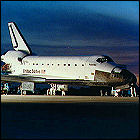 Space Shuttle Atlantis is launched on a mission involving a classified Defense Department payload, staying in Earth orbit for nearly five days. Atlantis’ crew on this flight consists of Commander Richard Covey, Pilot Frank Culbertson, and mission specialists Robert Springer, Carl Meade and Charles Gemar.
Space Shuttle Atlantis is launched on a mission involving a classified Defense Department payload, staying in Earth orbit for nearly five days. Atlantis’ crew on this flight consists of Commander Richard Covey, Pilot Frank Culbertson, and mission specialists Robert Springer, Carl Meade and Charles Gemar.
STS-41
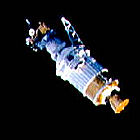 Space Shuttle Discovery lifts off to deliver another space probe whose launch has been delayed in recent years, the Ulysses mission. The remnant of a more elaborate (but ultimately scrapped) International Solar Polar mission, Ulysses is the first and only shuttle payload to use a two-stage booster to launch it from Earth orbit into a high, looping trajectory out of the plane of the ecliptic (roughly corresponding to the sun’s equator, around which the solar system’s planets orbit). Ulysses, built and managed by the European Space Agency, promises the first views of the sun’s polar regions. Discovery’s crew is Commander Richard N. Richards, Pilot Robert Cabana, and mission specialists William Shepherd, Bruce Melnick and Thomas Akers. Discovery lands at Edwards Air Force Base after four days in orbit.
Space Shuttle Discovery lifts off to deliver another space probe whose launch has been delayed in recent years, the Ulysses mission. The remnant of a more elaborate (but ultimately scrapped) International Solar Polar mission, Ulysses is the first and only shuttle payload to use a two-stage booster to launch it from Earth orbit into a high, looping trajectory out of the plane of the ecliptic (roughly corresponding to the sun’s equator, around which the solar system’s planets orbit). Ulysses, built and managed by the European Space Agency, promises the first views of the sun’s polar regions. Discovery’s crew is Commander Richard N. Richards, Pilot Robert Cabana, and mission specialists William Shepherd, Bruce Melnick and Thomas Akers. Discovery lands at Edwards Air Force Base after four days in orbit.
STS-31: launching Hubble
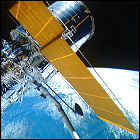 In the planning stages since the 1970s, and delayed by the post-Challenger-disaster downtime for the shuttle program, the Hubble Space Telescope is finally lifted into orbit aboard Space Shuttle Discovery. Hubble is just one of the scientific payloads for the five-day flight, with other experiments being conducted in the crew cabin and the cargo bay. Discovery’s crew for this flight is Commander Loren Shriver, Pilot Charles Bolden, and mission specialists Steven Hawley, Bruce McCandless and Kathryn Sullivan.
In the planning stages since the 1970s, and delayed by the post-Challenger-disaster downtime for the shuttle program, the Hubble Space Telescope is finally lifted into orbit aboard Space Shuttle Discovery. Hubble is just one of the scientific payloads for the five-day flight, with other experiments being conducted in the crew cabin and the cargo bay. Discovery’s crew for this flight is Commander Loren Shriver, Pilot Charles Bolden, and mission specialists Steven Hawley, Bruce McCandless and Kathryn Sullivan.
STS-36
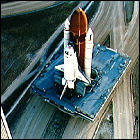 Space Shuttle Atlantis lifts off on a four-day Department of Defense mission, the specifics of which remain classified. The crew consists of Commander John Creighton, Pilot John Casper, and mission specialists Richard Mullane, David Hilmers and Pierre Thuot.
Space Shuttle Atlantis lifts off on a four-day Department of Defense mission, the specifics of which remain classified. The crew consists of Commander John Creighton, Pilot John Casper, and mission specialists Richard Mullane, David Hilmers and Pierre Thuot.
STS-32
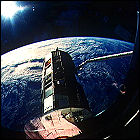 Space Shuttle Columbia lifts off on a ten-day mission to deploy the LEASAT 5 communications satellite and retrieve the Long Duration Exposure Facility satellite that had been placed in orbit in 1984 by Challenger. (LDEF retrieval, delayed from 1985, had been put off by several additional years by the Challenger accident and its aftermath.) Aboard Columbia in this flight are Commander Daniel Brandenstein, Pilot James Wetherbee, and mission specialists Bonnie Dunbar, G. David Low, and Marsha Ivins.
Space Shuttle Columbia lifts off on a ten-day mission to deploy the LEASAT 5 communications satellite and retrieve the Long Duration Exposure Facility satellite that had been placed in orbit in 1984 by Challenger. (LDEF retrieval, delayed from 1985, had been put off by several additional years by the Challenger accident and its aftermath.) Aboard Columbia in this flight are Commander Daniel Brandenstein, Pilot James Wetherbee, and mission specialists Bonnie Dunbar, G. David Low, and Marsha Ivins.
STS-33
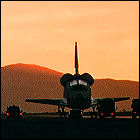 Space Shuttle Discovery lifts off on 1989’s fifth and final shuttle launch, delivering a classified Defense Department payload into orbit on a five-day mission. Aboard Discovery are Commander Frederick Gregory, Pilot John Blaha, and mission specialists Story Musgrave, Manley Carter, and Kathryn Thornton.
Space Shuttle Discovery lifts off on 1989’s fifth and final shuttle launch, delivering a classified Defense Department payload into orbit on a five-day mission. Aboard Discovery are Commander Frederick Gregory, Pilot John Blaha, and mission specialists Story Musgrave, Manley Carter, and Kathryn Thornton.
STS-34
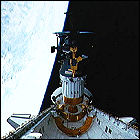 Space Shuttle Atlantis lifts off on a mission lasting nearly five days, whose primary goal is to lift the interplanetary probe Galileo into orbit. Originally intended for launch in late 1982, Galileo is bound for Jupiter by way of a long, looping trajectory that sends it to Venus and back to Earth multiple times, picking up speed via gravitational assist with each visit. Galileo won’t actually reach Jupiter itself until December 1995. Aboard Atlantis for this flight are Commander Donald Williams, Pilot Michael McCulley, and mission specialists Franklin Chang-Diaz, Shannon Lucid, and Ellen S. Baker.
Space Shuttle Atlantis lifts off on a mission lasting nearly five days, whose primary goal is to lift the interplanetary probe Galileo into orbit. Originally intended for launch in late 1982, Galileo is bound for Jupiter by way of a long, looping trajectory that sends it to Venus and back to Earth multiple times, picking up speed via gravitational assist with each visit. Galileo won’t actually reach Jupiter itself until December 1995. Aboard Atlantis for this flight are Commander Donald Williams, Pilot Michael McCulley, and mission specialists Franklin Chang-Diaz, Shannon Lucid, and Ellen S. Baker.
The People vs. Galileo?
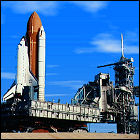 A lawsuit, filed by environmental activists worried about the release of plutonium from the Galileo Jupiter probe’s radioisotope thermoelectric generators in the event of a Challenger-like disaster during launch, is dismissed by a federal judge; the President of the United States has also given permission for the launch to proceed (a requirement anytime a nuclear-fueled spacecraft is in the works). The suit, filed earlier in the year, sought an injunction to prevent Galileo from being launched. Times have changed since the last RTG-powered flight (the Voyager missions of the 1970s), and activists are concerned about a Chernobyl-style radioactive disaster, although the plutonium 238 at the heart of Galileo’s power supply (and that of other interplanetary probes that have used it) is non-weapons-grade and non-fissible. Galileo is slated to be launched in a week aboard the space shuttle Atlantis.
A lawsuit, filed by environmental activists worried about the release of plutonium from the Galileo Jupiter probe’s radioisotope thermoelectric generators in the event of a Challenger-like disaster during launch, is dismissed by a federal judge; the President of the United States has also given permission for the launch to proceed (a requirement anytime a nuclear-fueled spacecraft is in the works). The suit, filed earlier in the year, sought an injunction to prevent Galileo from being launched. Times have changed since the last RTG-powered flight (the Voyager missions of the 1970s), and activists are concerned about a Chernobyl-style radioactive disaster, although the plutonium 238 at the heart of Galileo’s power supply (and that of other interplanetary probes that have used it) is non-weapons-grade and non-fissible. Galileo is slated to be launched in a week aboard the space shuttle Atlantis.
STS-28
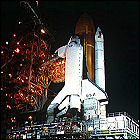 Lifting off on its first spaceflight since January 1986, Space Shuttle Columbia heads into orbit on a five-day classified Department of Defense mission. Columbia’s crew for this flight consists of Commander Brewster Shaw, Pilot Richard Richards, and mission specialists James Adamson, David Leestma and Mark Brown.
Lifting off on its first spaceflight since January 1986, Space Shuttle Columbia heads into orbit on a five-day classified Department of Defense mission. Columbia’s crew for this flight consists of Commander Brewster Shaw, Pilot Richard Richards, and mission specialists James Adamson, David Leestma and Mark Brown.